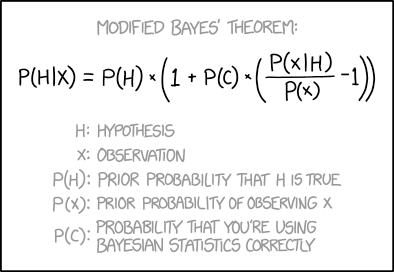Difference between revisions of "2059: Modified Bayes' Theorem"
(→Transcript) |
(Wrote a stub explanation.) |
||
| Line 8: | Line 8: | ||
==Explanation== | ==Explanation== | ||
| − | {{incomplete|Please edit the explanation below and only mention here why it isn't complete. Do NOT delete this tag too soon.}} | + | {{incomplete|Created by a PROBABLE HYPOTHESIS. Please edit the explanation below and only mention here why it isn't complete. Do NOT delete this tag too soon.}} |
| + | Bayes' Theorem is an equation in statistics that gives the probability of a given hypothesis accounting not only for a single experiment or observation, but also for your existing knowledge about the hypothesis, i.e. it's prior probability. Randall's modified form of the equation also purports to account for the probability that you are indeed applying Bayes' Theorem itself correctly by including that as a term in the equation. | ||
==Transcript== | ==Transcript== | ||
Revision as of 16:43, 15 October 2018
| Modified Bayes' Theorem |
 Title text: Don't forget to add another term for "probability that the Modified Bayes' Theorem is correct." |
Explanation
| |
This explanation may be incomplete or incorrect: Created by a PROBABLE HYPOTHESIS. Please edit the explanation below and only mention here why it isn't complete. Do NOT delete this tag too soon. If you can address this issue, please edit the page! Thanks. |
Bayes' Theorem is an equation in statistics that gives the probability of a given hypothesis accounting not only for a single experiment or observation, but also for your existing knowledge about the hypothesis, i.e. it's prior probability. Randall's modified form of the equation also purports to account for the probability that you are indeed applying Bayes' Theorem itself correctly by including that as a term in the equation.
Transcript
| |
This transcript is incomplete. Please help editing it! Thanks. |
- Modified Bayes' theorem:
P(H|X) = P(H) * (1 + P(C) * (P(X|H)/P(X) - 1))
- H: Hypothesis
- X: Observation
- P(H): Prior probability that H is true
- P(X): Prior propability of observing X
- P(C): Propability that you're using Bayesian statistics correctly
Discussion
Right now the layout is awful:
- "If
 the..."
the..." - should look like this:
- "If P(C)=1 the..."
But there is more wrong right now. Look at a typical Wikipedia article, the Math-extension should be used for formulas but not in the floating text. --Dgbrt (talk) 20:03, 15 October 2018 (UTC)
- Credit for a good explanation though. It made perfect sense to me, even though I didn't understand it. 162.158.167.42 04:14, 16 October 2018 (UTC)
I removed this, because it makes no sense:
- As an equation, the rewritten form makes no sense.
 is strangely self-referential and reduces to the piecewise equation
is strangely self-referential and reduces to the piecewise equation  . However, the Modified Bayes Theorem includes an extra variable not listed in the conditioning, so a person with an AI background might understand that Randal was trying to write an expression for updating
. However, the Modified Bayes Theorem includes an extra variable not listed in the conditioning, so a person with an AI background might understand that Randal was trying to write an expression for updating  with knowledge of
with knowledge of  i.e.
i.e.  , the belief in the hypothesis given the observation
, the belief in the hypothesis given the observation  and the confidence that you were applying Bayes' theorem correctly
and the confidence that you were applying Bayes' theorem correctly  , for which the expression
, for which the expression  makes some intuitive sense.
makes some intuitive sense.
Between removing it and posting here, I think that I've figured out what it's saying. But it comes down to criticizing a mistake made in an earlier edit by the same editor, so I'll just fix that mistake instead.
—TobyBartels (talk) 13:03, 16 October 2018 (UTC)
What about examples of correct and incorrect use of Bayes' Theorem? I don't feel equal to executing that, but DNA evidence in a criminal case could be illuminating. As a sketch, it may show that of 7 billion people alive today, the blood at the scene came from any one of just 10,000 people of which the accused is one. Interesting, but not absolute. At least 9,999 of the 10,000 are innocent. Probability of mistake or malfeasance by the testing laboratory also needs to be considered. Then there's sports drug testing, disease screening with imperfect tests and rare true positives, etc. [email protected] 141.101.76.82 09:42, 17 October 2018 (UTC)
Where is the next comic button for this page? IYN (talk) 15:46, 17 October 2018 (UTC)
